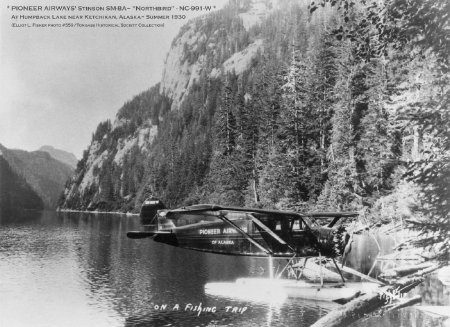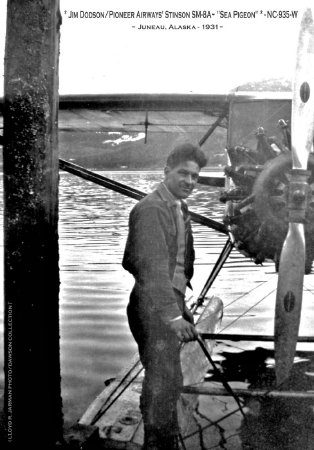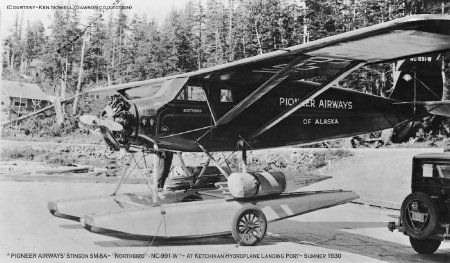Description:
Pioneer Airways, 1930-1931
Pacific Northwest commercial aviation entrepreneur Vern C. Gorst knew making a profit charter flying in Alaska required more just than sending up a single airplane and crew to work the summer fishing season independently with meager support, testing the odds of attrition. Especially when competing against the dominant rival company Alaska-Washington Airways' fleet of Lockheed Vega seaplanes. The obvious solution would be additional airplanes based in the region year-round with good financial backing, dedicated facilities, and experienced staff.
With that formula in mind, Gorst formed a partnership with local businessman Claude R. Wright to found Pioneer Airways in Ketchikan on June 18, 1930. Pioneer Alaska bush pilot Roy F. Jones, was hired as the new company's business manager. Now working as a resident carpenter, Jones was eager to get back into the aviation game. The WWI veteran flier learned much from his short but eventful Southeast Alaska Panhandle commercial aviation experience gained while operating Northbird Aviation Company from 1922 to 1923; familiarity with the territory would be an invaluable asset.
The company promptly purchased two factory new 4-place Stinson SM-8A Junior monoplanes, mounted on Edo Mod. 3300 floats. One was dubbed the "Sea Pigeon" (NC935W) and the other as "Northbird II" (NC991W), in honor of Jones' pioneer Curtiss MF Seagull converted navy biplane flying boat. Booking offices were established in both Ketchikan and Juneau. Available services and charter rates were well advertised: $40/hr. and Student instruction $35/hr. Being local, Pioneer Airways had its advantages, especially regarding use of the newly constructed Ketchikan municipal hydroplane landing port facility located at North Tongass Highway and Shoreline Drive. Plans were drawn up to build an add-on seaplane hangar building on the deck ramp for Pioneer Airways to maintain their aircraft.
On Saturday, June 21, 1930, the Sea Pigeon arrived in Ketchikan from Seattle to inaugurate service. Loren McHenry was the pilot with Claude Wright and Roy Jones aboard. The beautiful and sleek looking new Stinson sported striking company paint scheme of gloss black with bright orange on the upper wing surfaces and fuselage trim stripes. Its sister ship, Northbird II, wore identical colors and was scheduled to arrive in late July. Roy Jones' first company with the flying boat was a hard luck Alaska bush plane outfit, if there ever was. Unfortunately, despite Pioneer Airways' hopeful ambitions, fate repeated itself.
A week after arrival, the Sea Pigeon was badly damaged at Reflection Lake on June 29 when pilot McHenry overshot during his takeoff run. In late July, a spare float was transported from Ketchikan to Yes Bay via chartered fishing boat. A work party led by Roy Jones, accompanied by newly hired ex-Gorst mechanic John Selby, ex-U.S. Navy flier Jim Dodson (who arrived on July 22 as McHenry's replacement), and the boat's skipper packed it up 3 miles to the lake. It took a week to effect repairs on the airplane's damaged fuselage and a wingtip, and to replace the pontoon and struts. On August 1, Dodson made his first Pioneer Airways flight with a successful takeoff from the lake with the Sea Pigeon for its test flight and ferry trip back to the hydroplane port base. With their other ship due to arrive soon, the Sea Pigeon was sent south to complete the plane recovery repairs.
On Monday, August 4, 1930, Jim Dodson flew in with Northbird II to resume Ketchikan service. The company's big new hangar, which was being constructed on the seaplane port, was nearing completion. Dodson was kept busy logging numerous charter flights of every type around Ketchikan and to remote destinations, including Juneau and Sitka. On August 21, the Sea Pigeon returned from final repairs in Seattle. The pilot was none other than Gerry Smith, who'd served as Roy Jones' flight mechanic on the original Northbird when it made its historic July 17, 1922 inaugural Ketchikan debut. Smith brought up Pioneer Airways mechanics John Selby and Tom Johnson to keep both the Stinsons operational. The air-sea environment in the Panhandle was really humming the summer of 1930 with the abundance of commercial airplanes at work. There's a fascinating vintage photo of Ketchikan City Float taken August 22 that captures four seaplanes at the dock simultaneously; both Pioneer Airways' Stinsons and Alaska-Washington Airways' Vegas "Wrangell" and "Sitka".
That September, Pioneer Airways' fortunes went into a downward spiral. On September 19, the Northbird II sank during a storm while tied up at the Ketchikan dock when wind-driven waves flooded the pontoons, taking it offline to undergo repairs. Five days later, on September 24, the Sea Pigeon was swamped making an emergency landing in Juneau, and required repairs. One bit of bright news came on October 4, when Pioneer Airways' new Ketchikan hangar at the hydroplane port was finished. That same day, Sea Pigeon was test-flown and returned to service. All of the assorted operational misfortunes took their toll on the outfit, while constituting some serious déjà vu for poor Roy Jones. He resigned his Pioneer Airway managerial position in November, and left Ketchikan with his family for Seattle to take a flying job with U.S. Customs.
The company's pair of Stinsons kept flying out of Ketchikan and Juneau through the winter, while gearing up for another busy season in the spring of 1931. However, the heavy hand of fate reigned down one final time for Pioneer Airways on May 3, 1931, when the Sea Pigeon crashed taking off from Salmon Lake (aka Upper Karta Lake) on Prince of Wales Island with three passengers aboard on a cannery business charter with the loss of one soul. Though badly injured, pilot Jim Dodson rendered aid to the two survivors and attempted to find help. Rescue came via the timely arrival of an Alaska-Washington Airways' Vega search plane crewed by pilot Gene Meyring and mechanic Burras Smith. The sad accident marked Alaskan aviation's first ticketed passenger fatality and the end of Pioneer Airways.
Aircraft Specifications:
4-place Stinson SM-8A Junior (aka "Detroiter") Seaplane Version on Edo Mod. 3300 Floats (NC935W and NC991W). First Flight: 1928. 321 built (all variants) from 1928-1933. Factory Price: $5,775 (April 1930, without floats). Dimensions: Length: 28' 11"; Wingspan: 41' 6". Weights: Standard Empty Weight: 3,500 lbs.; Fuel Capacity: 61 gal. Performance: Airspeed: 100 mph cruise; Service Ceiling: 14,000 ft.; Range: 500 mi. Engine: Air-cooled 9 Cylinder 215 hp Lycoming R-680 Radial. Propeller: 2-Blade Fixed-Pitch.
Pilots:
Loren H. McHenry, Jim Dodson, Ray Howard, and Gerry Smith.
Mechanics:
John Selby, Ray Howard, and Tom Johnson.
With that formula in mind, Gorst formed a partnership with local businessman Claude R. Wright to found Pioneer Airways in Ketchikan on June 18, 1930. Pioneer Alaska bush pilot Roy F. Jones, was hired as the new company's business manager. Now working as a resident carpenter, Jones was eager to get back into the aviation game. The WWI veteran flier learned much from his short but eventful Southeast Alaska Panhandle commercial aviation experience gained while operating Northbird Aviation Company from 1922 to 1923; familiarity with the territory would be an invaluable asset.
The company promptly purchased two factory new 4-place Stinson SM-8A Junior monoplanes, mounted on Edo Mod. 3300 floats. One was dubbed the "Sea Pigeon" (NC935W) and the other as "Northbird II" (NC991W), in honor of Jones' pioneer Curtiss MF Seagull converted navy biplane flying boat. Booking offices were established in both Ketchikan and Juneau. Available services and charter rates were well advertised: $40/hr. and Student instruction $35/hr. Being local, Pioneer Airways had its advantages, especially regarding use of the newly constructed Ketchikan municipal hydroplane landing port facility located at North Tongass Highway and Shoreline Drive. Plans were drawn up to build an add-on seaplane hangar building on the deck ramp for Pioneer Airways to maintain their aircraft.
On Saturday, June 21, 1930, the Sea Pigeon arrived in Ketchikan from Seattle to inaugurate service. Loren McHenry was the pilot with Claude Wright and Roy Jones aboard. The beautiful and sleek looking new Stinson sported striking company paint scheme of gloss black with bright orange on the upper wing surfaces and fuselage trim stripes. Its sister ship, Northbird II, wore identical colors and was scheduled to arrive in late July. Roy Jones' first company with the flying boat was a hard luck Alaska bush plane outfit, if there ever was. Unfortunately, despite Pioneer Airways' hopeful ambitions, fate repeated itself.
A week after arrival, the Sea Pigeon was badly damaged at Reflection Lake on June 29 when pilot McHenry overshot during his takeoff run. In late July, a spare float was transported from Ketchikan to Yes Bay via chartered fishing boat. A work party led by Roy Jones, accompanied by newly hired ex-Gorst mechanic John Selby, ex-U.S. Navy flier Jim Dodson (who arrived on July 22 as McHenry's replacement), and the boat's skipper packed it up 3 miles to the lake. It took a week to effect repairs on the airplane's damaged fuselage and a wingtip, and to replace the pontoon and struts. On August 1, Dodson made his first Pioneer Airways flight with a successful takeoff from the lake with the Sea Pigeon for its test flight and ferry trip back to the hydroplane port base. With their other ship due to arrive soon, the Sea Pigeon was sent south to complete the plane recovery repairs.
On Monday, August 4, 1930, Jim Dodson flew in with Northbird II to resume Ketchikan service. The company's big new hangar, which was being constructed on the seaplane port, was nearing completion. Dodson was kept busy logging numerous charter flights of every type around Ketchikan and to remote destinations, including Juneau and Sitka. On August 21, the Sea Pigeon returned from final repairs in Seattle. The pilot was none other than Gerry Smith, who'd served as Roy Jones' flight mechanic on the original Northbird when it made its historic July 17, 1922 inaugural Ketchikan debut. Smith brought up Pioneer Airways mechanics John Selby and Tom Johnson to keep both the Stinsons operational. The air-sea environment in the Panhandle was really humming the summer of 1930 with the abundance of commercial airplanes at work. There's a fascinating vintage photo of Ketchikan City Float taken August 22 that captures four seaplanes at the dock simultaneously; both Pioneer Airways' Stinsons and Alaska-Washington Airways' Vegas "Wrangell" and "Sitka".
That September, Pioneer Airways' fortunes went into a downward spiral. On September 19, the Northbird II sank during a storm while tied up at the Ketchikan dock when wind-driven waves flooded the pontoons, taking it offline to undergo repairs. Five days later, on September 24, the Sea Pigeon was swamped making an emergency landing in Juneau, and required repairs. One bit of bright news came on October 4, when Pioneer Airways' new Ketchikan hangar at the hydroplane port was finished. That same day, Sea Pigeon was test-flown and returned to service. All of the assorted operational misfortunes took their toll on the outfit, while constituting some serious déjà vu for poor Roy Jones. He resigned his Pioneer Airway managerial position in November, and left Ketchikan with his family for Seattle to take a flying job with U.S. Customs.
The company's pair of Stinsons kept flying out of Ketchikan and Juneau through the winter, while gearing up for another busy season in the spring of 1931. However, the heavy hand of fate reigned down one final time for Pioneer Airways on May 3, 1931, when the Sea Pigeon crashed taking off from Salmon Lake (aka Upper Karta Lake) on Prince of Wales Island with three passengers aboard on a cannery business charter with the loss of one soul. Though badly injured, pilot Jim Dodson rendered aid to the two survivors and attempted to find help. Rescue came via the timely arrival of an Alaska-Washington Airways' Vega search plane crewed by pilot Gene Meyring and mechanic Burras Smith. The sad accident marked Alaskan aviation's first ticketed passenger fatality and the end of Pioneer Airways.
Aircraft Specifications:
4-place Stinson SM-8A Junior (aka "Detroiter") Seaplane Version on Edo Mod. 3300 Floats (NC935W and NC991W). First Flight: 1928. 321 built (all variants) from 1928-1933. Factory Price: $5,775 (April 1930, without floats). Dimensions: Length: 28' 11"; Wingspan: 41' 6". Weights: Standard Empty Weight: 3,500 lbs.; Fuel Capacity: 61 gal. Performance: Airspeed: 100 mph cruise; Service Ceiling: 14,000 ft.; Range: 500 mi. Engine: Air-cooled 9 Cylinder 215 hp Lycoming R-680 Radial. Propeller: 2-Blade Fixed-Pitch.
Pilots:
Loren H. McHenry, Jim Dodson, Ray Howard, and Gerry Smith.
Mechanics:
John Selby, Ray Howard, and Tom Johnson.
Click to Enlarge





